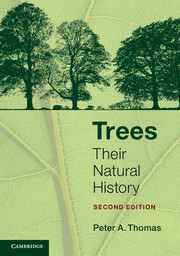Book contents
- Frontmatter
- Epigraph
- Contents
- Preface
- Chapter 1 An overview
- Chapter 2 Leaves: the food producers
- Chapter 3 The trunk and branches: more than a connecting drainpipe
- Chapter 4 Roots: the hidden tree
- Chapter 5 Towards the next generation: flowers, fruits and seeds
- Chapter 6 The growing tree
- Chapter 7 The shape of trees
- Chapter 8 The next generation: new trees from old
- Chapter 9 Age, health, damage and death: living in a hostile world
- Chapter 10 Trees and us
- Further Reading
- Index
- References
Chapter 4 - Roots: the hidden tree
Published online by Cambridge University Press: 05 July 2014
- Frontmatter
- Epigraph
- Contents
- Preface
- Chapter 1 An overview
- Chapter 2 Leaves: the food producers
- Chapter 3 The trunk and branches: more than a connecting drainpipe
- Chapter 4 Roots: the hidden tree
- Chapter 5 Towards the next generation: flowers, fruits and seeds
- Chapter 6 The growing tree
- Chapter 7 The shape of trees
- Chapter 8 The next generation: new trees from old
- Chapter 9 Age, health, damage and death: living in a hostile world
- Chapter 10 Trees and us
- Further Reading
- Index
- References
Summary
A common view of tree roots is that they plunge deep into the ground producing almost a mirror image of the canopy. Yet in reality a tree usually looks more like a wine glass with the roots forming a wide but shallow base (Figure 4.1). Most trees fail to root deeply because it is physically difficult and unnecessary. The two main functions of roots are to take up water and minerals, and to hold the tree up. In normal situations, water is most abundant near the soil surface (from rain), and this is also where the bulk of dead matter accumulates and decomposes releasing minerals (nitrogen, potassium, etc.). It should not be surprising, therefore, to find that the majority of tree roots are near the soil surface. The flat ‘root plate’ also serves very well for holding up the tree; deep roots are not needed (see Chapter 9).
Roots have other functions as well. They store food for later use (see Chapter 3) and they play an important role in determining the size of the tree. Roots normally account for 20–30% of a tree’s mass (although it varies from as little as 15% in some rainforest trees up to 50% in arid climates). However, if the trunk is ignored (which forms 40–60% of the total mass), the canopy and the roots come out at roughly the same mass. This helps put into perspective the relative value of the roots and the leaves to each other. Too few roots and the canopy suffers from lack of water. Too few leaves and the roots get insufficient food. There has to be a balance. The roots ‘control’ the canopy partly through water supply but also by the production of hormones. If you doubt this control, think of fruit trees that are kept small by being grafted onto dwarfing root stock.
- Type
- Chapter
- Information
- TreesTheir Natural History, pp. 102 - 153Publisher: Cambridge University PressPrint publication year: 2014



